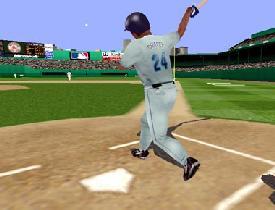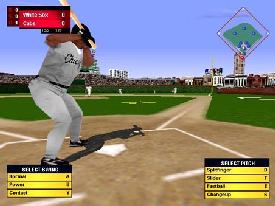Microsoft strikes out.
Like a 23 year-old Triple-A phenom, Microsoft Baseball 3D has amazing potential, but still needs a few years of seasoning before entering The Show. Unfortunately, we gamers aren’t likely to be as patient as Felipe Alou — we want results now, and this latest attempt at arcade baseball just doesn’t deliver.
The big problem here is gameplay. Sure the folks at Microsoft have worked up some top-notch eye-candy. But unlimited camera angles, an MLB license, modeled battings stances and individually drawn faces just doesn’t mean squat if you can’t field the damn ball. With most games, a problem like this is the result of sluggish controls or skipped frames in the animation. With Microsoft Baseball 3D, it’s just the opposite – the controls are too responsive, making embarrassing errors the norm, and the lightning quick animation and changing camera angles are so disorienting that even routine ground balls will just blow right by your dumbfounded infielders. Though you can choose a “computer assisted fielding” option, there’s really no point — rather than assist you, the AI just takes over, moving your fielder to the ball and making the play all on its own.
The pitching/batting interface is just as irksome. Though the game provides a wonderful amount of control — you can actually move your batter in the box, choose one of three swing types, locate the position of the swing and perform a check swing — it is incredibly difficult to master. If this weren’t enough, it’s hard to tell balls from strikes and the computer controlled pitchers have unbelievable control.

On the user-controlled pitching end, things fare a little better, but there are a few problems here as well. Like most baseball games, you select a pitch type and while the pitcher begins his windup you move the aiming cursor around the strike zone. Unlike the competition, however, each pitcher is limited to four types of pitches. On the positive side, you can modify each pitch with an “energy boost” (an increase in speed for heaters and movement for breaking balls), but I had trouble using this unique feature to good effect. Much like the “jumping” and “diving” buttons for fielding, and the base running “slide” and “lead” commands, these innovative features are hard to get the hang of.
If all this weren’t enough, Microsoft Baseball suffers in the realism department as well. Though the game has all the elements to provide a more realistic experience than its competitors (even 3DO’s High Heat), there are almost no walks; pinch-hitting substitutions rarely make sense; starting pitchers are often left in the game long after they should have been replaced by relievers; players without power in the real world can hit three homers a game; line drives are way too frequent; and, for some reason, current season stats are not accessible during play, making pitching and fielding strategy rather hit or miss.
There is much to like about Microsoft Baseball 3D – namely, the complex control mechanism, which could, if fine-tuned, make for the most realistic game of baseball we’ve yet to see in a PC arcade title. But as it stands now (I’ve given up hope on the promised patch), I can’t recommend this game to anyone but the most dexterous button pushers who are not offended by the aforementioned lapses in baseball logic. Let’s hope the 1999 Edition will fix these nagging problems, because MS Baseball 3D could truly be a gem.
-
Great graphics
-
Player editor
-
Difficult to control
-
Lapses in baseball logic
-
Annoying commentators







